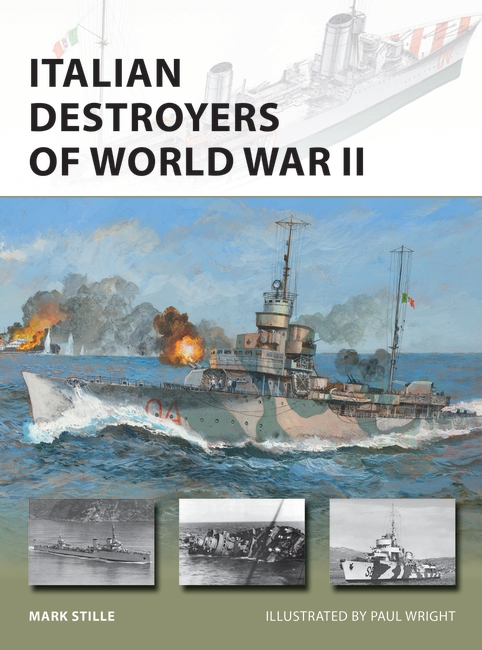On the blog today, Mark Stille briefly examines the history of RM Destroyers during World War II, the subject of his upcoming New Vanguard title, Italian Destroyers of World War II.
The history of the Italian Royal Navy (Regia Marina or RM) during World War II is an interesting one. As a whole, the RM did well since it accomplished its primary mission of keeping the sea lines of communications from Italy to North Africa open for most of the war. It also closed off the Central Mediterranean to the Allies for most of the same period. However, when the force components of the RM are examined in detail, they almost always underperformed. This was certainly the case with the RM’s destroyer force.
When hostilities began, the RM had 59 destroyers in service. This was a fragile force since Italian industry could not replace war losses. Only five destroyers were completed during the war. Added to this, another five were captured and put into RM service. With these, the RM fought a prolonged and costly naval campaign that accounted for 50 of its 59 pre-war destroyers. RM destroyers fought not only in the Mediterranean, but also in a forgotten campaign in the Red Sea. Losses were extremely heavy even though RM commanders had an almost universal reluctance, and often direct orders, not to risk the fleet against a superior enemy force. These losses demonstrate that the RM was not afraid to fight. In particular, the destroyers fought a series of brave, but futile, actions against the British Royal Navy.
The RM built large and apparently well-armed destroyers. However, upon closer examination, RM destroyers were sadly deficient in all warfare areas and were certainly inferior to their British counterparts. The main weapon of Italian destroyers was a heavy main gun battery, not their torpedoes. But Italian naval gunnery suffered a vital defect across the board, that being an excessive dispersion problem. This was certainly the case at long ranges, which was the preferred RM tactic. As a result, RM destroyer gunnery was ineffective; on no occasion did an Italian destroyer sink an enemy warship by gunfire.
Unlike most other navies’ destroyers, RM destroyers carried a small torpedo battery. On the few occasions during the war when Italian destroyers were called on to conduct torpedo attacks, their small torpedo battery proved to be a disadvantage. Italian destroyers carried only four to six torpedoes, and during the war this was reduced to three on many ships. The resulting size of an Italian destroyer torpedo spread was small, and this was further reduced by the RM doctrine of holding some torpedoes in reserve. Italian torpedo gunnery was further crippled by poor torpedo fire control systems. Only one enemy warship was sunk by an Italian destroyer torpedo during the entire war.
Antiair warfare was also a salient weakness. This was not uncommon among other navies’ pre-war destroyers, but the RM never addressed this problem and it became crippling after their destroyers were exposed to an increased air threat. RM destroyers lacked a dual-purpose main battery weapon, which meant that antiaircraft protection was almost entirely dependent on a small number of short-range 20mm guns. When these ships were exposed to air attack, losses were heavy.
Antisubmarine warfare was another problem area since RM destroyers did not possess the weapons, sensors, or training to conduct modern antisubmarine warfare. For example, no RM destroyer carried sonar at the start of the war. Only 12 were so equipped by June 1942. In addition, these ships carried a limited number of depth charges.
Another example of RM destroyers not being prepared or equipped for modern war was a lack of radar. Only eight destroyers received radar during the war and those so equipped received it late in the war. As a result, RM destroyers were at a severe disadvantage in night action. This was a real problem since the British sought night engagements. Lack of night-fighting equipment and training, combined with the RM’s total lack of radar until late in the war, meant that Italian destroyers were almost helpless in night combat.
Another overlooked handicapp was lack of endurance. RM destroyers were designed for operations in the Mediterranean and thus possessed limited endurance. This translated into a short range of action, which precluded operations into the western or eastern Mediterranean. Additionally, most were lightly built and suffered from stability problems and poor seakeeping. On the Navigatori class for example, stability was especially bad after 50 percent of the fuel had been used. The system for replacing fuel with seawater was suspect and often resulted in contaminated fuel. Reducing top weight and adding ballast on the Navigatoris eventually solved this problem, but the stability on other classes remained suspect. Not until the Maestrale class in the mid 1930s did Italian destroyer designers address this issue satisfactorily.
All of the issues mentioned above made for a less than stellar war record. Of the 59 destroyers available at the start of the war in June 1940, combined with the five war-built ships, only 12 survived to join the Allies in September 1943. In return, RM destroyers sank only one British destroyer and a handful of submarines. The RM’s destroyer force fought bravely, but its ships were ill suited for modern war.
Italian Destroyers of World War II publishes later this month. Preorder your copy today!


Comments
You must be logged in to comment on this post. Click here to log in.
Submit your comment